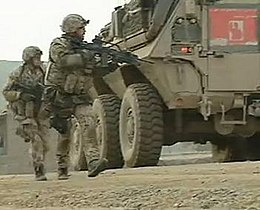
Back مكافحة التمرد في شمال أفغانستان Arabic ISAF-Operationsführung im Raum Kundus (2009–2014) German Campaña de Qundūz Spanish د افغانستان په شمال کې د بلوا ضد مبارزه Pashto/Pushto
| Counterinsurgency in Northern Afghanistan | |||||||
|---|---|---|---|---|---|---|---|
| Part of the War in Afghanistan (2001–2021) | |||||||
 German troops in combat in Chardara | |||||||
| |||||||
| Belligerents | |||||||
|
Coalition |
Insurgents | ||||||
| Commanders and leaders | |||||||
|
Coalition Notable leadership |
Notable leadership | ||||||
| Strength | |||||||
|
Coalition |
Insurgents | ||||||
| Casualties and losses | |||||||
|
Coalition at least 570 Others 3 KIA, 10 WIA |
Insurgents 1,140+ | ||||||
|
Civilian casualties at least 120 killed or wounded 3 contractors killed | |||||||

The following addresses the events in Northern Afghanistan between April 2009 and 2014. While this part of the country had long been relatively peaceful compared to the all-out war zones of the south and east, tensions would flare up again in 2008 when the German soldiers deployed to the area came under attack more often, leading to the deaths of the several soldiers.[9] Previously hindered by national caveats,[10] the deteroriating security situation prompted the German-led Regional Command North to launch a series of operations to take on the rising insurgency. Concerted operations began after an insurgent attack on PRT Kunduz within minutes of German Chancellor Angela Merkel's departure from a visit.[11] Within two years, the German presence would be doubled and additional reinforcements from the American ISAF contingent were called in, including heavy German armoured vehicles and US aviation assets, allowing for a more aggressive approach towards the insurgency.
- ^ a b c Baur (2021), p. 19.
- ^ a b Baur (2021), p. 21.
- ^ Augengeradeaus.net
- ^ Bernama [1] Archived 2011-06-04 at the Wayback Machine
- ^ Bundeswehr press release [2] Archived 2016-03-10 at the Wayback Machine
- ^ Dawn.com Dawn.com[permanent dead link]
- ^ Al Jazeera [3] Archived 2016-12-04 at the Wayback Machine
- ^ "Bundeswehr press release". Archived from the original on 2016-03-10. Retrieved 2016-03-10.
- ^ RP.online (archived)
- ^ "NATO at War: Understanding the Challenges of Caveats in Afghanistan", David P. Auerswald / Stephen M. Saideman, 2009 [4][permanent dead link]
- ^ Deutsche Welle [5] Archived 2009-04-09 at the Wayback Machine
© MMXXIII Rich X Search. We shall prevail. All rights reserved. Rich X Search